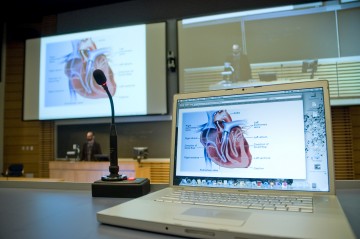In autumn, MedIT participated in the inaugural National Technician Exchange for distributed medical programs in Canada. The University of Toronto, Dalhousie University and the University of British Columbia sent technicians from their medical programs to visit their peers at other institutions in an attempt to answer the question “what can we do better, together?”
 Distributed medical programs operate in a unique space. Their successful delivery requires not only the smooth integration of audiovisual and information technology, but an understanding of how this technology intersects with academic and clinical environments. Sitting at the crossroads of technology, academia, and the medical field are the technicians who ensure everything operates smoothly. These technicians frequently face unique situations that other audiovisual technicians would rarely have to consider, from academic copyright issues to viewing graphic medical images.
Distributed medical programs operate in a unique space. Their successful delivery requires not only the smooth integration of audiovisual and information technology, but an understanding of how this technology intersects with academic and clinical environments. Sitting at the crossroads of technology, academia, and the medical field are the technicians who ensure everything operates smoothly. These technicians frequently face unique situations that other audiovisual technicians would rarely have to consider, from academic copyright issues to viewing graphic medical images.
As exchange participant Garth Evans explained, “There is no guide book on how to be a ‘Collaborations Technician’ in a medical program; it’s a unique and broad skill set. This was an opportunity for those with that skill set to share experiences and develop best practices.”
The exchange started with MedIT hosting Ian Taylor, Technical Operations Manager from the Faculty of Medicine at Dalhousie University, and Brian Ruryk, Audio Visual Specialist from the Faculty of Medicine at the University of Toronto. In their week-long visits, Taylor and Ruryk had the opportunity to observe MedIT’s operations in four distributed medical program sites: Vancouver, Victoria, Prince George and Kelowna.
In the weeks following, MedIT technicians travelled eastward to observe the programs of their peers. Chris Bateman, an Audiovisual Specialist from the Vancouver Fraser Medical Program, visited Ruryk at the University of Toronto. He had the opportunity to tour facilities and observe operations at campuses in Toronto and Mississauga. Garth Evans, an Audiovisual Support Analyst from the Southern Medical Program, visited Taylor at Dalhousie University, and Dalhousie Medicine New Brunswick (Dalhousie’s distributed site in Saint John).
 The results of the exchange went beyond original expectations. In learning how other programs operate, the technicians turned the lens back on their own programs to ask “What are we doing well? What could we do differently?”
The results of the exchange went beyond original expectations. In learning how other programs operate, the technicians turned the lens back on their own programs to ask “What are we doing well? What could we do differently?”
The exchange also revealed that the challenges that one program is facing may have already been overcome by a different program. Relationships were established that will allow participants to connect on a one-on-one basis in the future. “Now I can directly call somebody at UBC or Dalhousie and ask them if they’ve faced a similar challenge,” says Ruryk, “It’s a smaller world.”
In an effort to sustain the process of knowledge exchange, the three programs are pursuing the development of a National Technical Operations Working Group. This group will act as a formal venue for the programs to share their challenges and solutions, and ultimately improve the delivery of each medical program.